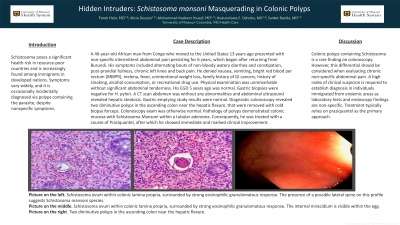Monday Poster Session
Category: Colon
P1967 - Hidden Intruders: Schistosoma mansoni Masquerading in Colonic Polyps
Monday, October 28, 2024
10:30 AM - 4:00 PM ET
Location: Exhibit Hall E

Has Audio

Farah Heis, MD
University of Missouri Health Care
Columbia, MO
Presenting Author(s)
Farah Heis, MD1, Alicia Dessain, MD2, Muhammad Nadeem. Yousaf, MD1, Ibukunoluwa E. Oshobu, MD1, Sanket Basida, MD3
1University of Missouri Health Care, Columbia, MO; 2University of Missouri, Columbia, MO; 3University of Missouri School of Medicine, Columbia, MO
Introduction: Schistosoma poses a significant health risk in resource-poor countries and is increasingly found among immigrants in developed nations. Symptoms vary widely, and it is occasionally incidentally diagnosed via polyps containing the parasite, despite nonspecific symptoms.
Case Description/Methods: A 46-year-old African man from Congo who moved to the United States 13 years ago presented with non-specific intermittent abdominal pain persisting for 6 years, which began after returning from Burundi. His symptoms included alternating bouts of non-bloody watery diarrhea and constipation, post-prandial fullness, chronic left knee and back pain. He denied nausea, vomiting, bright red blood per rectum (BRBPR), melena, fever, unintentional weight loss, family history of GI cancers, history of smoking, alcohol consumption, or recreational drug use. Physical examination was unremarkable without significant abdominal tenderness. His EGD 5 years ago was normal. Gastric biopsies were negative for H. pylori. A CT scan abdomen was without any abnormalities and abdominal ultrasound revealed hepatic steatosis. Gastric emptying study results were normal. Diagnostic colonoscopy revealed two diminutive polyps in the ascending colon near the hepatic flexure, that were removed with cold biopsy forceps. Colonoscopy exam was otherwise normal. Pathology of polyps demonstrated colonic mucosa with Schistosoma Mansoni within a tubular adenoma. Consequently, he was treated with a course of Praziquantel, after which he showed immediate and marked clinical improvement.
Discussion: Colonic polyps containing Schistosoma is a rare finding on colonoscopy. However, this differential should be considered when evaluating chronic non-specific abdominal pain. A high index of clinical suspicion is required to establish diagnosis in individuals immigrated from endemic areas as laboratory tests and endoscopy findings are non-specific. Treatment typically relies on praziquantel as the primary approach.
.

Disclosures:
Farah Heis, MD1, Alicia Dessain, MD2, Muhammad Nadeem. Yousaf, MD1, Ibukunoluwa E. Oshobu, MD1, Sanket Basida, MD3. P1967 - Hidden Intruders: Schistosoma mansoni Masquerading in Colonic Polyps, ACG 2024 Annual Scientific Meeting Abstracts. Philadelphia, PA: American College of Gastroenterology.
1University of Missouri Health Care, Columbia, MO; 2University of Missouri, Columbia, MO; 3University of Missouri School of Medicine, Columbia, MO
Introduction: Schistosoma poses a significant health risk in resource-poor countries and is increasingly found among immigrants in developed nations. Symptoms vary widely, and it is occasionally incidentally diagnosed via polyps containing the parasite, despite nonspecific symptoms.
Case Description/Methods: A 46-year-old African man from Congo who moved to the United States 13 years ago presented with non-specific intermittent abdominal pain persisting for 6 years, which began after returning from Burundi. His symptoms included alternating bouts of non-bloody watery diarrhea and constipation, post-prandial fullness, chronic left knee and back pain. He denied nausea, vomiting, bright red blood per rectum (BRBPR), melena, fever, unintentional weight loss, family history of GI cancers, history of smoking, alcohol consumption, or recreational drug use. Physical examination was unremarkable without significant abdominal tenderness. His EGD 5 years ago was normal. Gastric biopsies were negative for H. pylori. A CT scan abdomen was without any abnormalities and abdominal ultrasound revealed hepatic steatosis. Gastric emptying study results were normal. Diagnostic colonoscopy revealed two diminutive polyps in the ascending colon near the hepatic flexure, that were removed with cold biopsy forceps. Colonoscopy exam was otherwise normal. Pathology of polyps demonstrated colonic mucosa with Schistosoma Mansoni within a tubular adenoma. Consequently, he was treated with a course of Praziquantel, after which he showed immediate and marked clinical improvement.
Discussion: Colonic polyps containing Schistosoma is a rare finding on colonoscopy. However, this differential should be considered when evaluating chronic non-specific abdominal pain. A high index of clinical suspicion is required to establish diagnosis in individuals immigrated from endemic areas as laboratory tests and endoscopy findings are non-specific. Treatment typically relies on praziquantel as the primary approach.
.

Figure: Picture on the left. Schistosoma ovum within colonic lamina propria, surrounded by strong eosinophilic granulomatous response. The presence of a possible lateral spine on this profile suggests Schistosoma mansoni species.
Picture on the middle. Schistosoma ovum within colonic lamina propria, surrounded by strong eosinophilic granulomatous response. The internal miracidium is visible within the egg.
Picture on the right. Two diminutive polyps in the ascending colon near the hepatic flexure.
Picture on the middle. Schistosoma ovum within colonic lamina propria, surrounded by strong eosinophilic granulomatous response. The internal miracidium is visible within the egg.
Picture on the right. Two diminutive polyps in the ascending colon near the hepatic flexure.
Disclosures:
Farah Heis indicated no relevant financial relationships.
Alicia Dessain indicated no relevant financial relationships.
Muhammad Yousaf indicated no relevant financial relationships.
Ibukunoluwa Oshobu indicated no relevant financial relationships.
Sanket Basida indicated no relevant financial relationships.
Farah Heis, MD1, Alicia Dessain, MD2, Muhammad Nadeem. Yousaf, MD1, Ibukunoluwa E. Oshobu, MD1, Sanket Basida, MD3. P1967 - Hidden Intruders: Schistosoma mansoni Masquerading in Colonic Polyps, ACG 2024 Annual Scientific Meeting Abstracts. Philadelphia, PA: American College of Gastroenterology.
